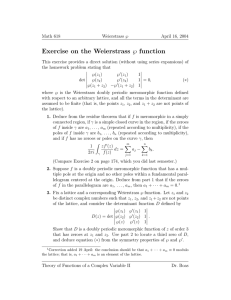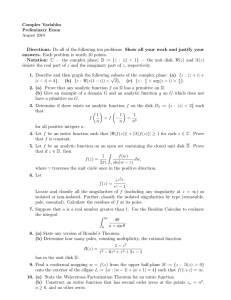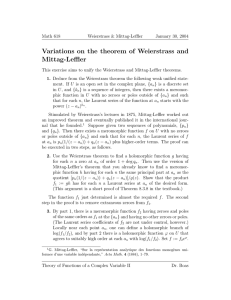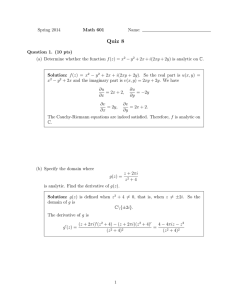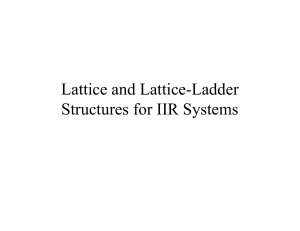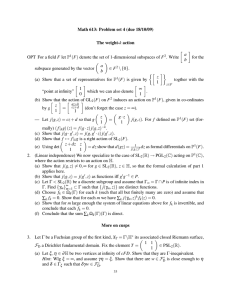The Weierstrass Function Fix β, γ ∈ (0, ∞). Then 1 X
advertisement
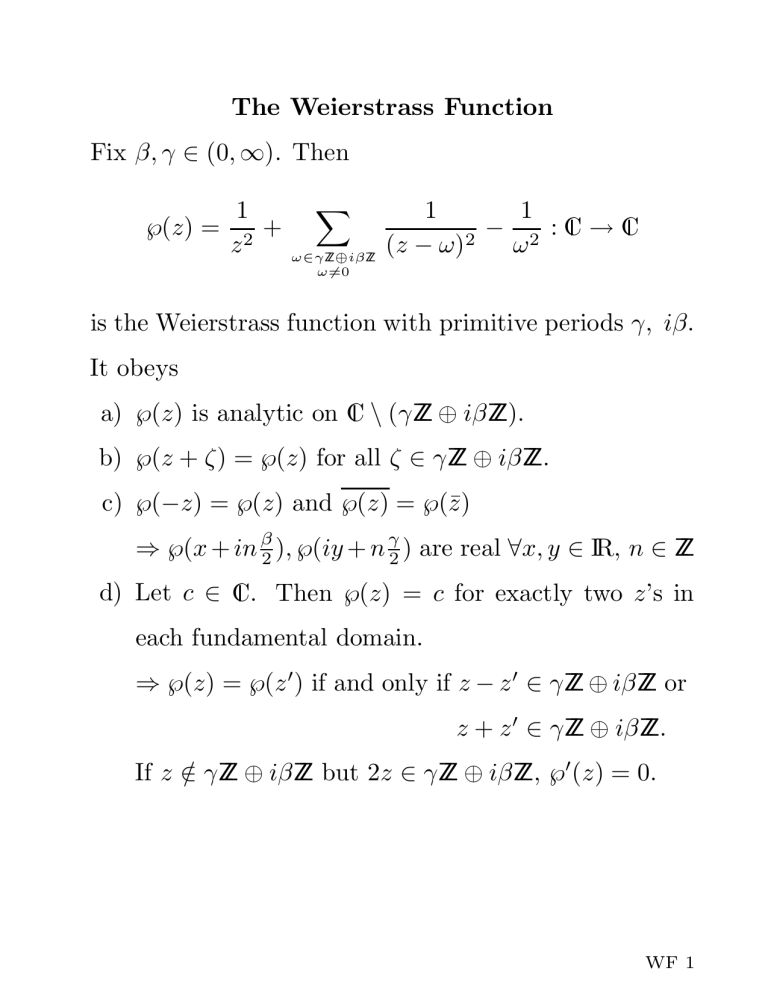
The Weierstrass Function Fix β, γ ∈ (0, ∞). Then 1 ℘(z) = 2 + z X ω∈γZZ⊕iβZZ ω6=0 1 1 − :C→C 2 2 (z − ω) ω is the Weierstrass function with primitive periods γ, iβ. It obeys a) ℘(z) is analytic on C \ (γZZ ⊕ iβZZ). b) ℘(z + ζ) = ℘(z) for all ζ ∈ γZZ ⊕ iβZZ. c) ℘(−z) = ℘(z) and ℘(z) = ℘(z̄) ⇒ ℘(x + in β2 ), ℘(iy + n γ2 ) are real ∀x, y ∈ IR, n ∈ ZZ d) Let c ∈ C. Then ℘(z) = c for exactly two z’s in each fundamental domain. ⇒ ℘(z) = ℘(z 0 ) if and only if z − z 0 ∈ γZZ ⊕ iβZZ or z + z 0 ∈ γZZ ⊕ iβZZ. If z ∈ / γZZ ⊕ iβZZ but 2z ∈ γZZ ⊕ iβZZ, ℘0 (z) = 0. WF 1 Theorem W.2 Let f (z) be a nonconstant meromorphic function that is periodic with respect to Ω = ω1 ZZ + ω2 ZZ. Suppose that f (z) has poles of order n1 , · · · , nk at p1 + Ω, · · · , pk + Ω and is analytic elsewhere. Let c be any complex number. Suppose that f (z) − c has zeroes of order m1 , · · · , mh at z1 + Ω, · · · , zh + Ω and is nonzero elsewhere. Then h X i=1 Idea of Proof. mi = k X nk i=1 For any nonconstant meromorphic function f (z) and any domain D Z f 0 (z) f (z) dz = 2πi # zeroes in D − # poles in D ∂D Choose D of the form z0 + ω 2 z0 z0 + ω 1 with no zeroes or poles on D. WF 2 Weierstrass Function Relatives Define ζ(z) = 1 z + X 1 z−ω + 1 ω + z ω2 ω∈γZZ⊕iβZZ ω6=0 σ(z) = z Y 1− z ω ω∈γZZ⊕iβZZ ω6=0 e 1 z2 z + ω 2 ω2 They obey a) ζ(z) is analytic on C \ (γZZ ⊕ iβZZ). σ(z) is entire and vanishes if and only if z ∈ γZZ ⊕ iβZZ. b) ζ(z) = σ 0 (z) σ(z) and ℘(z) = −ζ 0 (z). c) There are constants η1 ∈ IR , η2 ∈ iIR satisfying η1 iβ − η2 γ = 2πi such that ζ(z + γ) = ζ(z) + η1 ζ(z + iβ) = ζ(z) + η2 σ(z + iβ) = −σ(z) e η2 (z+i β 2) σ(z + γ) = −σ(z) e η1 (z+ γ2 ) d) ζ(−z) = −ζ(z) and ζ(z) = ζ(z̄). ⇒ ζ(x) ∈ IR ∀x ∈ IR and ζ(iy) ∈ iIR ∀y ∈ IR σ(−z) = −σ(z) and σ(z) = σ(z̄). WF 3 e) ℘(u + v) + ℘(u) + ℘(v) = ζ(u + v) − ζ(u) − ζ(v) 2 Idea of Proof. For each fixed v ∈ C \ (γZZ ⊕ iβZZ), both the left and right hand sides are periodic and have double poles, with the same singular part, at each u ∈ γZZ ⊕ iβZZ and each u ∈ −v + γZZ ⊕ iβZZ. Define k(z) = −i ζ(z) − z ηγ1 It obeys a) k(z) is analytic on C \ (γZZ ⊕ iβZZ). b) k(z + γ) = k(z) and k(z + iβ) = k(z) − 2π γ . c) k(−z) = −k(z) and k(z) = −k(z̄). γ ⇒ k(iy), k iy + 2 ∈ IR for all y ∈ IR. k(x) ∈ iIR, k(x + i β2 ) ∈ π γ + iIR for all x ∈ IR. WF 4 Set, for z ∈ C \ γZZ ⊕ iβZZ , ϕ(z, x) = e ζ(z)x σ z σ λ(z) = −℘(z) k(z) = −i ζ(z) − − x − i β2 β x + i2 z ηγ1 ξ(z) = eγik(z) = eγζ(z)−zη1 Lemma S.11 a) d2 − dx2 ϕ(z, x) + 2℘ x + i β2 ϕ(z, x) = λ(z)ϕ(z, x) b) ϕ(z, x + γ) = ξ(z) ϕ(z, x) c) ξ(z + γ) = ξ(z) ξ(z + iβ) = ξ(z) LM 1 a) First observe that β d σ z −x−i2 dx σ x + i β2 0 β β β 0 σ x + i2 σ z − x− i2 σ z −x−i2 =− + β β β σ z −x−i2 σ x + i2 σ x + i2 β h i σ z −x−i2 β β = − ζ z − x − i2 + ζ x + i2 β σ x+ i2 β β d ⇒ dx ϕ(z, x) = ζ(z)−ζ z − x − i 2 −ζ x + i 2 ϕ(z, x) Proof: As ζ(u + v) − ζ(u) − ζ(v) d2 dx2 ϕ(z, x) 0 i β2 2 0 = ℘(u + v) + ℘(u) + ℘(v) i β2 = ζ z−x− −ζ x+ ϕ(z, x) β β 2 + ζ(z) − ζ z − x − i 2 − ζ x + i 2 ϕ(z, x) β β = − ℘ z − x − i 2 − ℘ x + i 2 ϕ(z, x) β β 2 + ζ(z) − ζ z − x − i 2 − ζ x + i 2 ϕ(z, x) β β = − ℘ z − x − i 2 − ℘ x + i 2 ϕ(z, x) β β + ℘(z) + ℘ z − x − i 2 + ℘ x + i 2 ϕ(z, x) β = ℘(z) + 2℘ x + i 2 ϕ(z, x) LM 2 b) β ζ(z)(x+γ) σ z − x − γ − i 2 ϕ(z, x + γ) = e β σ x+γ +i2 β ζ(z)(x+γ) σ − z + x + γ + i 2 = −e β σ x+γ +i2 η (−z+x+i β + γ ) β 1 2 2 ζ(z)(x+γ) σ − z + x + i 2 e = −e η (x+i β + γ ) β 2 2 σ x + i2 e 1 β ζ(z)(x+γ) −η1 z σ z − x − i 2 =e e β σ x + i2 ζ(z)γ−η1 z =e ϕ(z, x) c) ξ(z + γ) = eγζ(z+γ)−(z+γ)η1 = eγζ(z)−zη1 = ξ(z) ξ(z + iβ) = eγζ(z+iβ)−(z+iβ)η1 = eγη2 −iβη1 eγζ(z)−zη1 = ξ(z) LM 3 Set Γ = γZZ and ∞ (IR/Γ) V (x) = 2℘(x + i β2 ) ∈ CIR d 2 H = i dx + V (x) The Lamé equation is d2 − dx2 φ + 2℘(x + i β2 )φ = λφ (S.8) A solution φ(k, x) of (S.8) that satisfies φ(k, x + γ) = eiγk φ(k, x) (S.9) is called a Bloch solution with energy λ and quasimomentum k. Lemma S.11 says that, for each z ∈ C \ γZZ ⊕ iβZZ , ϕ(z, x) is a Bloch solution of the Lamé equation with energy λ = λ(z) and quasimomentum k = k(z). LM 4 The energy λ and multiplier ξ = eγik are fully parameterized by λ(z) = −℘(z) ξ(z) = eγζ(z)−zη1 That is, the boundary value problem (S.8), (S.9) has a nontrivial solution if and only if (λ, eiγk ) = (λ(z), ξ(z)), for some z ∈ C \ γZZ ⊕ iβZZ . Idea of Proof. Unless 2z ∈ γZZ ⊕ iβZZ, the functions ϕ(z, x) and ϕ(−z, x) are linearly independent (Lemma S.12) solutions of (S.8) for λ(z) = λ(−z). As a second order ordinary differential equation, (S.8) only has two linearly independent solutions for each fixed value of λ. For z ∈ γZZ ⊕ iβZZ, λ(z) is not finite. For 2z ∈ γZZ ⊕ iβZZ with z ∈ / γZZ ⊕ iβZZ, λ0 (z) = 0 and the second linearly independent solution is ∂ ∂z ϕ(z, x). LM 5 Theorem S.13 Set Λ1 = −℘( γ2 ) Λ2 = −℘( γ2 + i β2 ) Λ3 = −℘(i β2 ) Then Λ1 , Λ2 , Λ3 are real, Λ1 < Λ2 < Λ3 and the spec d 2 trum of H = i dx + 2℘(x + i β2 ) is [Λ1 , Λ2 ] ∪ [Λ3 , ∞). Proof: If, for given values of λ and k, the boundary value problem (S.8), (S.9) has a nontrivial solution and if k is real then λ is in the spectrum of H. We know that all such λ’s are also real. iβ γ + iβ γ 0 Imagine walking along the path in the z–plane that follows the four line segments from 0 to γ 2 to γ 2 + i β2 to LM 6 i β2 and back to 0. As ℘(z) = ℘(z̄), ℘(−z) = ℘(z) and ℘(z − γ) = ℘(z − iβ) = ℘(z), λ(z) = −℘(z) remains real throughout the entire excursion. Near z = 0, λ(z) = −℘(z) ≈ − z12 so λ starts out near −∞ at the beginning of the walk and moves continuously to +∞ at the end of the walk. Furthermore, as ℘(z) = ℘(z 0 ) if and only if z − z 0 ∈ γZZ ⊕ iβZZ or z + z 0 ∈ γZZ ⊕ iβZZ. λ never takes the same value twice on the walk, because no two distinct points z, z 0 on the walk obey z ± z 0 ∈ γZZ ⊕ iβZZ. • On the first quarter of the walk, from z = 0 to z = γ 2, λ(z) increases from −∞ to Λ1 = −℘( γ2 ). But we cannot put these λ’s into the spectrum of H because k(z) is pure imaginary on this part of the walk. LM 7 • On the second quarter of the walk, from z = γ 2 + −℘( γ2 + i β2 ). to z = γ 2 i β2 , λ(z) increases from Λ1 to Λ2 = As k(z) is pure real on this part of the walk, so these λ’s are in the spectrum of H. • On the third quarter of the walk, from z = γ 2 + i β2 to z = i β2 , λ(z) increases from Λ2 to Λ3 = −℘(i β2 ). These λ’s do not go into the spectrum of H, because k(z) has nonzero imaginary part. • On the last quarter of the walk, from z = i β2 back to zero, λ(z) increases from Λ3 to +∞. These λ’s are in the spectrum of H, because k(z) is pure real. LM 8
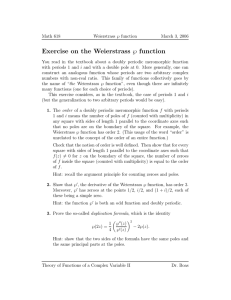
![Mathematics 414 2003–04 Exercises 5 [Due Monday February 16th, 2004.]](http://s2.studylib.net/store/data/010415766_1-b65af2bb66ab8e422354912dcedcb6a6-300x300.png)
